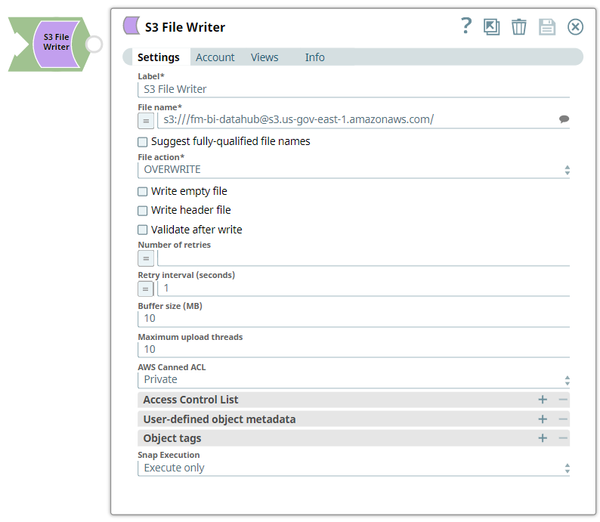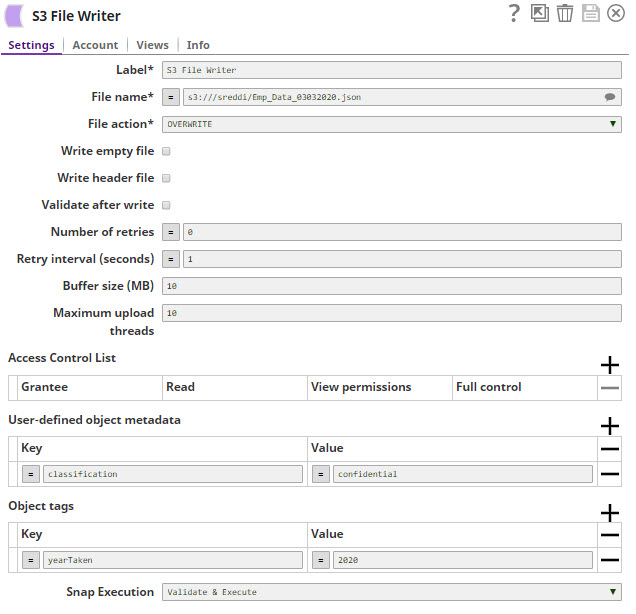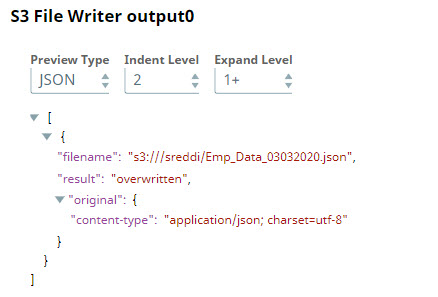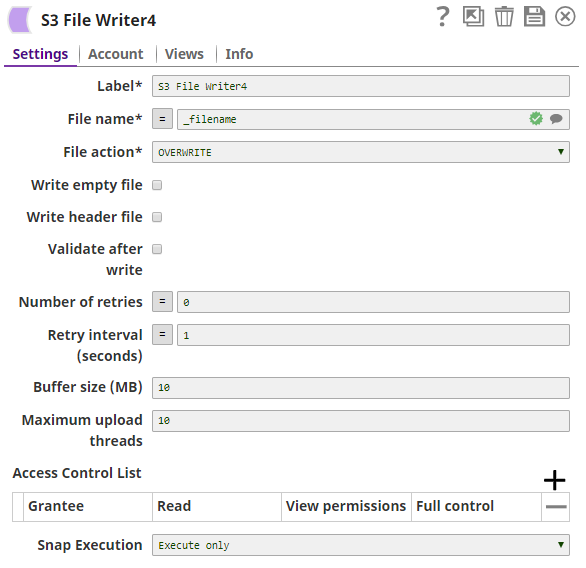In this article
| Table of Contents | ||||
|---|---|---|---|---|
|
Overview
The S3 File Writer Snap is a Write-type Snap that reads a binary data stream from its input view and writes it to an S3 file destination. If you provide values for File permissions, the Snap sets the permissions to the file.
| Info |
|---|
|
| Multiexcerpt include macro | ||||||||
|---|---|---|---|---|---|---|---|---|
|
Prerequisites
None.
Supported Features
Works in Ultra Task Pipelines.
Limitations and Known Issues
None.
Snap Views
Label*
Default Value:S3 File Writer
Example: S3 File Writer
Specify the name for the Snap. You can modify this to be more specific, especially if you have more than one of the same Snap in your Pipeline.
File name*
Default Value: s3:///
Examples:
s3:///mybucket@s3.eu-west-1.amazonaws.com/test.json- _filename (A key/value pair with "filename" key should be defined as a pipeline parameter)
- $filename (A key/value pair with "filename" key should be defined the input document)
Specify the URL for the S3 file, from where the binary data is to be read. This Snap also supports S3 Virtual Private Cloud (VPC) endpoint. For example, s3://my-bucket@bucket.vpce-028b7814794578709-vu0vvauy.s3.us-west-2.vpce.amazonaws.com
| Info |
|---|
The file name must start with |
Prerequisite: The provided account must have Read access to the specified S3 bucket in order to read the file successfully.
Using Expressions:
This property can be an expression with the Expression enabler enabled.
For example, if the File property is "s3:///mybucket/out_" + Date.now() + ".csv" then the evaluated filename is s3:///mybucket/out_2013-11-13T00:22:31.880Z.csv.
Syntax:
| Paste code macro |
|---|
s3:///<S3_bucket_name>@s3.<region_name>.amazonaws.com/<path> |
For region names and their details, see AWS Regions and Endpoints.
| Note | ||
|---|---|---|
| ||
Region name is optional only if the region is us-east-1. In all other cases the region name must be specified based on the syntax above. For example, mybucket@eu-west-1. For more information about regions, see AWS Regions and Endpoints. |
| Multiexcerpt include macro | ||||
|---|---|---|---|---|
|
| Multiexcerpt include macro | ||||
|---|---|---|---|---|
|
| View Type | View Format | Number of Views | Examples of Upstream and Downstream Snaps | Description | ||
|---|---|---|---|---|---|---|
| Input | Document |
|
| Any binary data stream. | ||
| Output | Document |
|
| If an output view is open and the file write action is successful, the output view provides a document with information on the filename, result, and original data. An example is:
| ||
Error | Document |
| N/A | The error view contains error, reason, resolution and stack trace. For more information, see Handling Errors with an Error Pipeline |
Optional Configuration
IAM Roles for Amazon EC2
To access S3 files from Groundplex nodes hosted in the EC2 environment without specifying Access-key ID and Secret key in AWS S3 account configured for the Snap, enable the ‘IAM_CREDENTIAL_FOR_S3’ feature. When you enable this feature, the IAM credential stored in EC2 metadata is used to access S3 buckets.
To enable the IAM_CREDENTIAL_FOR_S3 feature:
- Open Manager.
- Open the Snaplexes tab of the project that contains the EC2-based Groundplex.
- Click the Groundplex to open its Properties.
- Open the Node Properties tab.
- Add a new row in the Global properties section.
Specify
jcc.jvm_optionsas the Key and-DIAM_CREDENTIAL_FOR_S3=TRUEas the Value.Restart the JCC (node) to apply the changes. For more information about IAM Roles, refer to IAM Roles for Amazon EC2.
Snap Settings
| Info |
|---|
|
Error handling is a generic way to handle errors without losing data or failing the Snap execution. You can handle the errors that the Snap might encounter when running the pipeline by choosing one of the following options from the When errors occur list under the Views tab:
Learn more about Error handling in Pipelines. |
Snap Settings
| Info |
|---|
|
| Field Name | Field Type | Description | ||||||||||||||||||||||
|---|---|---|---|---|---|---|---|---|---|---|---|---|---|---|---|---|---|---|---|---|---|---|---|---|
Label* Default Value:S3 File Writer | String | Specify the name for the Snap. You can modify this to be more specific, especially if you have more than one of the same Snap in your pipeline. | ||||||||||||||||||||||
File name* Default Value: s3:/// Examples:
| String/Expression/Suggestion | Specify the URL for the S3 file, from where the binary data is to be read. This Snap also supports S3 Virtual Private Cloud (VPC) endpoint. For example,
Prerequisite: The provided account must have Read access to the specified S3 bucket in order to read the file successfully. Using Expressions: This property can be an expression with the Expression enabler enabled. For example, if the File property is "s3:///mybucket/out_" + Date.now() + ".csv" then the evaluated filename is s3:///mybucket/out_2013-11-13T00:22:31.880Z.csv. Syntax:
For region names and their details, see AWS Regions and Endpoints.
| ||||||||||||||||||||||
Suggest fully-qualified file names Default Value: Deselected | Checkbox | Select this checkbox to include the region and authority of the S3 bucket in the associated paths that appear in the Suggestion list.
| ||||||||||||||||||||||
File action* Default Value:OVERWRITE | Dropdown list | Specify the action to perform if the file already exists. The available options are:
| ||||||||||||||||||||||
Write empty file Default Value: Deselected | Checkbox | Write empty fileSelect this checkbox to include the region and authority of the S3 bucket in the associated paths that appear in the Suggestion list.
| Dropdown list | |||||||||||||||||||||
| Note |
|---|
Even though it is listed, Append is not supported for the S3 file protocol. |
write an empty file when the incoming binary document has empty data. If there is no incoming document at the input view of the Snap, no file is written regardless of the value of the property.
Write header file
Default Value: Deselected
Select this checkbox to write a header file whose name is generated by appending ".header" to the value of the File name property. The header file provides metadata about the file such as content disposition or content type. The same header information is also included in the output view data, as shown in the "Expected output" section above, under the key "original".
The binary data stream in the input view may contain header information about the binary data in the form of a document with key-value pair data.
| Info |
|---|
If the header has no keys other than Content-Type or Content-Encoding, the .header file is not written. |
Validate after write
DefaultValue: Deselected
Select this checkbox to
Write header file
Default Value: Deselected
Select this checkbox to write a header file whose name is generated by appending ".header" to the value of the File name property. The header file provides metadata about the file such as content disposition or content type. The same header information is also included in the output view data, as shown in the "Expected output" section above, under the key "original".
The binary data stream in the input view may contain header information about the binary data in the form of a document with key-value pair data.
| Info |
|---|
If the header has no keys other than Content-Type or Content-Encoding, the .header file is not written. |
Validate after write
DefaultValue: Deselected
Select this checkbox to allow the Snap to check if the file exists after writing the file.
Number of retries
Minimum value: 0
Default Value: 0Example:
allow the Snap to check if the file exists after writing the file.
Number of retries
Minimum value: 0
Default Value: 0
Example: 3
Specify the maximum number of retry attempts the Snap must make when it fails to write. If the value is larger than 0, the Snap first stores the input data in a temporary local file before writing to the target file.
| Info |
|---|
Ensure that the local drive has sufficient free disk space as large as the expected target file size. If the value is larger than 0, the Snap first downloads the target file into a temporary local file. If any error occurs during the download, the Snap waits for the time specified in the Retry interval and attempts to download the file again from the beginning. When the download is successful, the Snap streams the data from the temporary file to the downstream Pipeline. All temporary local files are deleted when they are no longer needed. |
Retry interval (seconds)
Minimum value: 1
Default Value: 1
Example: 3
Specify the
maximumminimum number of
retry attemptsseconds for which the Snap must
make when it fails to write. If the value is larger than 0, the Snap first stores the input data in a temporary local file before writing to the target file.| Info |
|---|
Ensure that the local drive has sufficient free disk space as large as the expected target file size. If the value is larger than 0, the Snap first downloads the target file into a temporary local file. If any error occurs during the download, the Snap waits for the time specified in the Retry interval and attempts to download the file again from the beginning. When the download is successful, the Snap streams the data from the temporary file to the downstream Pipeline. All temporary local files are deleted when they are no longer needed. |
Retry interval (seconds)
Minimum value: 1
Default Value: 1
Example: 3
Specify the minimum number of seconds for which the Snap must wait before attempting recovery from a network failure.
Buffer size(MB)
Default Value: 10 MB
Specify the data (in MB) to load into the S3 bucket, at a time.
The minimum data size you can upload is 6 MB.
wait before attempting recovery from a network failure.
Buffer size(MB)
Default Value: 10 MB
Specify the data (in MB) to load into the S3 bucket, at a time.
| Note |
|---|
|
Refer to Upload Part for more information on uploading to S3.
Maximum upload threads
Default Value: 10
Example:3
Specify the maximum number of threads to be used for the concurrent multipart upload. The minimum value allowed is 1.
| Note |
|---|
To upload S3 files that are more than 100 GB in size, we recommend you to set |
the Maximum upload threads to 10. Also, set the Buffer size to 100 MB or more |
; otherwise, many |
parallel HTTP connections |
may be opened, leading to the following error: "AmazonClientException: Unable to execute HTTP request: Timeout waiting for connection from pool". |
Refer to Upload Part for more information on uploading to S3.
Maximum upload threadsAWS Canned ACL
Default Value: 10None
Example: 3PublicRead
Specify the maximum number of threads to be used for the concurrent multipart upload. The minimum value allowed is 1.
| Note |
|---|
To upload S3 files that are more than 100 GB in size, we recommend you to set the Maximum upload threads to 10. Also, set the Buffer size to 100 MB or more; otherwise, many parallel HTTP connections may be opened, leading to the following error: "AmazonClientException: Unable to execute HTTP request: Timeout waiting for connection from pool". |
AWS Canned ACL
Default Value: None
Example: PublicRead
The predefined ACL grants (from AWS) to use when writing a file to S3. Choose a Canned ACL from the available options:
- None
- Private
- PublicRead
- PublicReadWrite
- AuthenticatedRead
- LogDeliveryWrite
- BucketOwnerRead
- BucketOwnerFullControl
- AwsExecRead
Watch the video for more information about AWS Canned ACL.
Learn more about AWS Canned ACLs.
Access Control List
Use this field set to define the Access Control List (ACL) to the specified S3 file. This filed set contains the following fields:
- Grantee
- Read
- View permissions
- Full control
| Note |
|---|
The account that you use for the Snap must have the required permissions to set the ACLs for the S3 object it is writing to. |
Select a grantee from the suggested list or enter a valid email address or a canonical ID associated to an AWS account. Canonical AWS ID can be obtained in the Security Credentials page of the AWS console.
| Info |
|---|
A grantee can be an AWS account or one of the predefined Amazon S3 groups. The following note is an excerpt from AWS document: "An email grantee is a grantee identified by their email address and authenticated by an Amazon system. email grants are internally converted to the canonical user representation when creating the ACL. If the grantee changes their email address, it will not affect existing Amazon S3 permissions. Adding a grantee by email address only works if exactly one Amazon account corresponds to the specified email address. If multiple Amazon accounts are associated with the email address, an AmbiguousGrantByEmail error message is returned. This happens rarely, but usually occurs if a user created an Amazon account in the past, forgotten the password, and created another Amazon account using the same email address. If this occurs, the user should contact Amazon customer service to have the accounts merged. Alternatively, grant user access specifying the canonical user representation." |
Examples:
- "Everyone"
- "Authenticated user"
- an email address used to create AWS account
- a canonical AWS ID, e.g. "1700891f3927e316dc4c9e18c789b32131880f48d3e03ac110aaf695b212573e"
"Everyone” option allows anyone in the world to access the file (authenticated or anonymous). Even when the bucket is protected with permission and if the file operation in the Snap under ACL->Grantee is set to 'Everyone', any user (authenticated or anonymous) can access the file. So, we highly recommend not to use this option as its unsafe.
| Note | ||
|---|---|---|
| ||
You can use Email addresses to specify a grantee only in the following regions:
For more information, see Specifying Grantee. |
The predefined ACL grants (from AWS) to use when writing a file to S3. Choose a Canned ACL from the available options:
- None
- Private
- PublicRead
- PublicReadWrite
- AuthenticatedRead
- LogDeliveryWrite
- BucketOwnerRead
- BucketOwnerFullControl
- AwsExecRead
Watch the video for more information about AWS Canned ACL.
Learn more about AWS Canned ACLs.
Access Control List
Use this field set to define the Access Control List (ACL) to the specified S3 file. This filed set contains the following fields:
- Grantee
- Read
- View permissions
- Full control
| Note |
|---|
The account that you use for the Snap must have the required permissions to set the ACLs for the S3 object it is writing to. |
Select a grantee from the suggested list or enter a valid email address or a canonical ID associated to an AWS account. Canonical AWS ID can be obtained in the Security Credentials page of the AWS console.
| Info |
|---|
A grantee can be an AWS account or one of the predefined Amazon S3 groups. The following note is an excerpt from AWS document: "An email grantee is a grantee identified by their email address and authenticated by an Amazon system. email grants are internally converted to the canonical user representation when creating the ACL. If the grantee changes their email address, it will not affect existing Amazon S3 permissions. Adding a grantee by email address only works if exactly one Amazon account corresponds to the specified email address. If multiple Amazon accounts are associated with the email address, an AmbiguousGrantByEmail error message is returned. This happens rarely, but usually occurs if a user created an Amazon account in the past, forgotten the password, and created another Amazon account using the same email address. If this occurs, the user should contact Amazon customer service to have the accounts merged. Alternatively, grant user access specifying the canonical user representation." |
Examples:
- "Everyone"
- "Authenticated user"
- an email address used to create AWS account
- a canonical AWS ID, e.g. "1700891f3927e316dc4c9e18c789b32131880f48d3e03ac110aaf695b212573e"
| Warning | ||
|---|---|---|
| ||
"Everyone” option allows anyone in the world to access the file (authenticated or anonymous). Even when the bucket is protected with permission and if the file operation in the Snap under ACL->Grantee is set to 'Everyone', any user (authenticated or anonymous) can access the file. So, we highly recommend not to use this option as its unsafe. |
| Note | ||
|---|---|---|
| ||
You can use Email addresses to specify a grantee only in the following regions:
For more information, see Specifying Grantee. |
This field set contains the following fields:
- Key
- Value
Specify the key name of the object metadata.
| Info |
|---|
The key names of the object metadata are case-insensitive. AWS S3 converts them to lower-case and prefixes them with “x-amz-meta-” when displayed in the AWS S3 web console. When the S3 File Reader Snap reads an S3 file, this metadata is shown in the header of the output binary data, and the key names are displayed in lower-case without the prefix “x-amz-meta-”. |
Use this field set to define key-value pairs for
user-definedobject
metadatatags of an S3 object.
For more information about user-defined object metadata, see Using MetadataThis Object tags enable you to categorize existing and new objects using key-value combinations. For details about the object tags, see Object Tagging. This field set contains the following fields:
- Key
- Value
Specify the key name of the object tag.
| Info |
|---|
The key names of object tags are case-sensitive. When the S3 File Reader Snap reads an S3 file, these object tags are displayed in the header of the output binary data. If a key name of an object tag is the same as another in the header, it is prefixed with “tag_”. See example Providing User-defined Object Metadata and Object Tags using the S3 File Writer Snap below for more information. |
Snap Execution
Specify the key name of the object
metadatatag.
| Info |
|---|
The key names of theobject metadatatags are case- insensitive. AWS S3 converts them to lower-case and prefixes them with “x-amz-meta-” when displayed in the AWS S3 web console.When the S3 File Reader Snap reads an S3 file, this metadata is shown in the header of the output binary data, and the key names are displayed in lower-case without the prefix “x-amz-meta-”. |
Use this field set to define key-value pairs for object tags of an S3 object. Object tags enable you to categorize existing and new objects using key-value combinations. For details about the object tags, see Object Tagging. This field set contains the following fields:
- Key
- Value
sensitive. When the S3 File Reader Snap reads an S3 file, these object tags are displayed in the header of the output binary data. If a key name of an object tag is the same as another in the header, it is prefixed with “tag_”. See example Providing User-defined Object Metadata and Object Tags using the S3 File Writer Snap below for more information. |
Snap Execution
| Multiexcerpt include macro | ||||
|---|---|---|---|---|
|
Optional Configuration
IAM Roles for Amazon EC2
To access S3 files from Groundplex nodes hosted in the EC2 environment without specifying Access-key ID and Secret key in AWS S3 account configured for the Snap, enable the ‘IAM_CREDENTIAL_FOR_S3’ feature. When you enable this feature, the IAM credential stored in EC2 metadata is used to access S3 buckets.
To enable the IAM_CREDENTIAL_FOR_S3 feature:
- Open Manager.
- Open the Snaplexes tab of the project that contains the EC2-based Groundplex.
- Click the Groundplex to open its Properties.
- Open the Node Properties tab.
- Add a new row in the Global properties section.
Specify
jcc.jvm_optionsas the Key and-DIAM_CREDENTIAL_FOR_S3=TRUEas the Value.Restart the JCC (node) to apply the changes. For more information about IAM Roles, refer to IAM Roles for Amazon EC2.
Examples
Providing User-defined Object Metadata and Object Tags using the S3 File Writer Snap
This example is a basic use case for the S3 File Writer Snap. It also demonstrates how you can configure the Snap with custom object metadata and object tags to classify the data.
In the sample Pipeline, the S3 File Writer Snap is configured as follows with the User-defined object metadata and Object tags:
The following is a preview of the output data from the S3 File Writer Snap:
When the S3 File Reader Snap reads this data, it picks up the user-defined object metadata and object tags we defined, as show below:
Typical Configuration
Key configuration of the Snap lies in how the values are passed. Values can be passed to the Snap:
Without Expressions
For example, the File name is passed directly to the Snap in the image below.
With Expressions
The File name is passed using Pipeline Parameters:
Downloads
| Multiexcerpt include macro | ||||
|---|---|---|---|---|
|
| Attachments | ||||||
|---|---|---|---|---|---|---|
|
See Also
| Insert excerpt | ||||||
|---|---|---|---|---|---|---|
|







